It’s been a bright and sunny sunflower summer. I always have sunflowers in my summer garden, presumably gifts from the digestive systems of a variety of birds and their fuzzy-tailed sunflower seed-loving friends, the squirrels. These urban dwelling critters disperse the remains of black-oiled sunflower seeds taken from feeders, dropped unceremoniously to the soil, which then fulfills its role in nurturing growth. This year, the numbers and sizes of sunflowers are over-the-top–literally. Each stalk is huge and there are scads of them. I pulled out quite a few, some when were very small and others as they grew taller, but my pruning shears were no match for the sunflowers determination to define my summer garden.

I kept most of the sunflowers at the center and back of my gardens so they wouldn’t interfere too much with beloved seasonal perennials like creamy Yarrow, Achillea millefolium and cheery Zexmenia, Wedelia acapulucensis var. hispida.

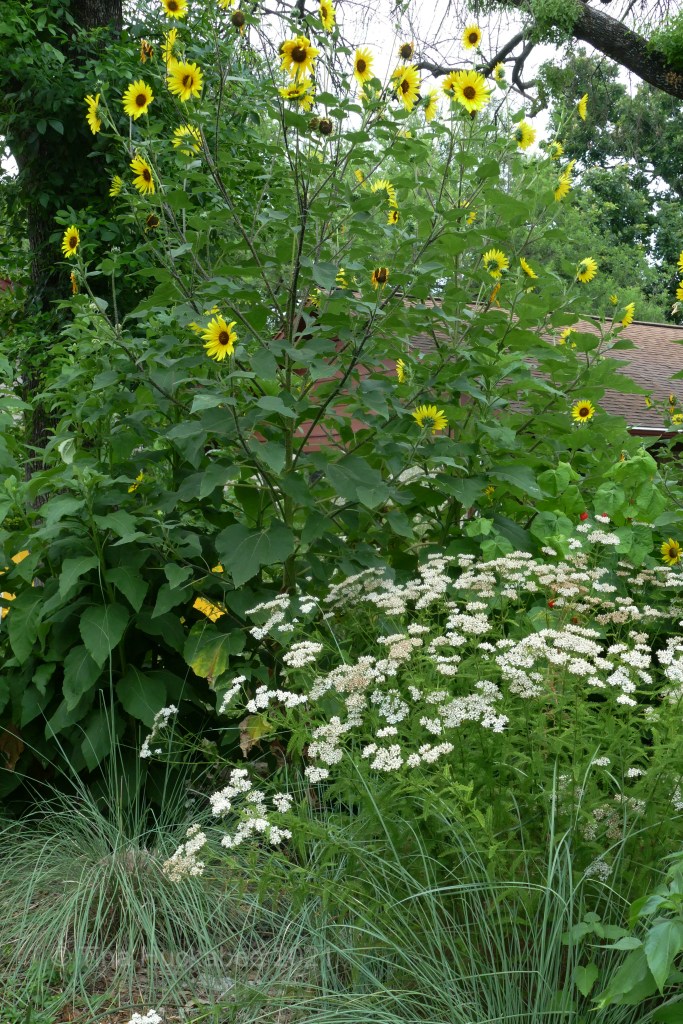
My home sits on the curve of the street and has no sidewalk. Toward my sister-in-law’s (SIL) home (right side of photo), I allowed the sunflowers to reach their sunny faces to the sky and form a floral barrier to the end of the garden.

From the other side, you can see that my SIL also took a pruning shears-off attitude toward the sunflowers in her garden (again, right side of photo). If anything, she may have more of these yellow monsters than we do!

A head-on photo of our two gardens gives you some idea of the statements these sunflowers make!

Also, you’ll notice that the trees look like it’s still we’re still in winter. Arizona Ash trees are the signature trees in both our front gardens and these two trees were badly damaged by February’s winter storm. They will never recover and will never again be fully foliaged trees. The green that you see, along the trunks and the lower branches, is all the trees will ever produce. We’ll be removing our trees later in in autumn. My once shady, west-facing front garden will become a full sun garden and changes are required. Some of the current garden inhabitants won’t like the Texas sun beating down everyday and will be removed; sun-lovers like native grasses and sun-worshipping perennials and shrubs will thrive in the heat and blossom with the blasts of daily sun. I’m sure whatever sunflowers show up next year will be perfectly happy in the new conditions. The end of a tree is a sad, sad thing and the end of two adjacent trees doubly so. I’ll miss their cooling effects, sweet movement of foliage in the wind, and the activities and songs of birds taking refuge in their canopies.
The pollinators have worked the sunflower since opening day in April or May. Honeybees are especially fond of sunflowers and are often covered with pollen after they’ve spent some time nuzzled in the flowers.
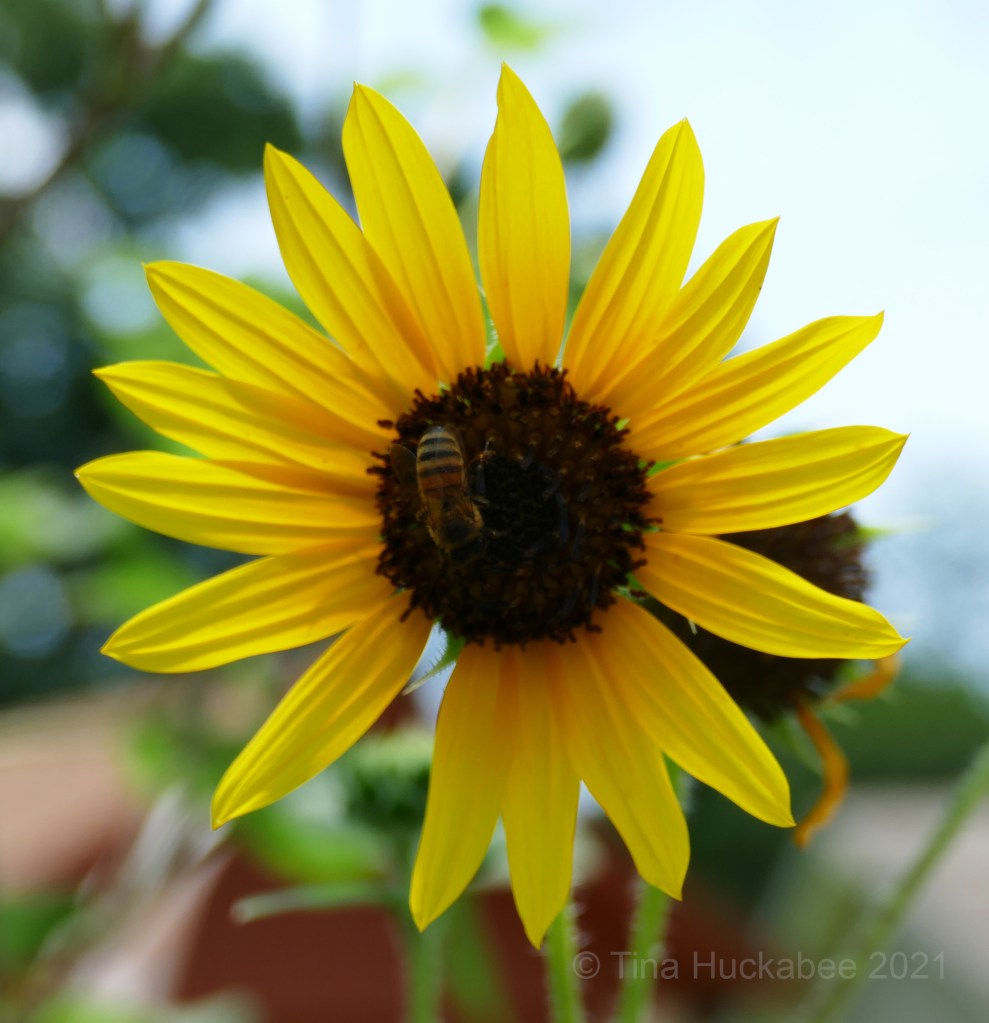
As blossoms fade, seeds develop and a new set of feeders show up for that bounty. This male Lesser Goldfinch, Spinus psaltria, is one of many birds who’ve enlivened the fading stalks with their busy munching. Feeding alongside the goldfinches are doves (both White-winged and Mourning), House Finches, House Sparrows, and Carolina Wrens. Often when I step outside, there’s a whoosh of wings and scatter of birds as all the eaters take flight.
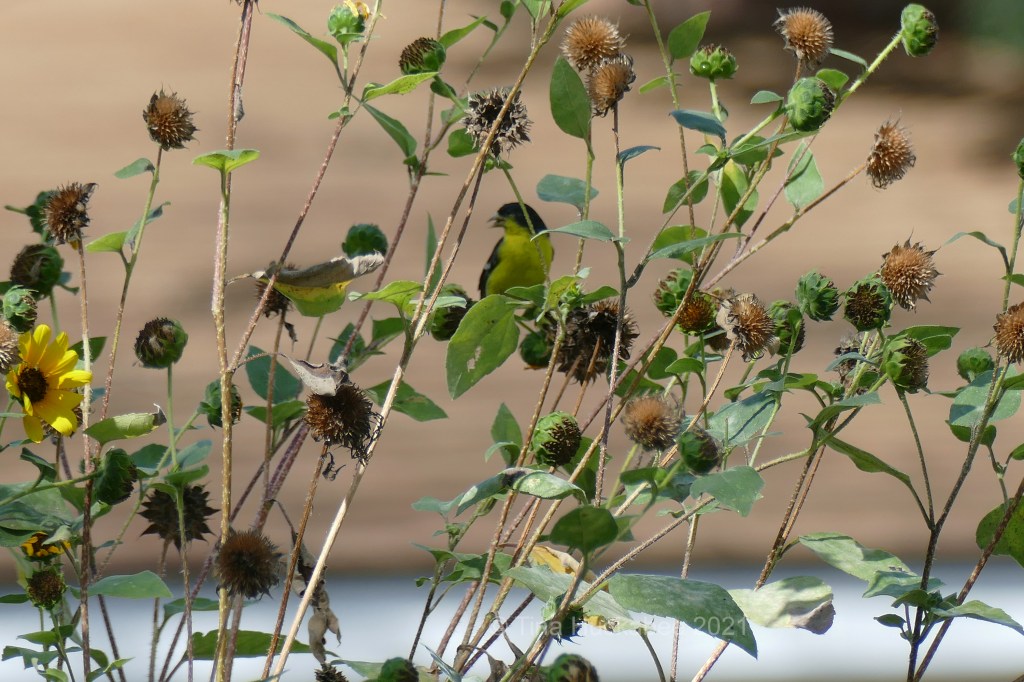
As the Lesser Goldfinch perches prettily, his belly is yellow; when he bends to eat seeds, his back sports cool white racing stripes!
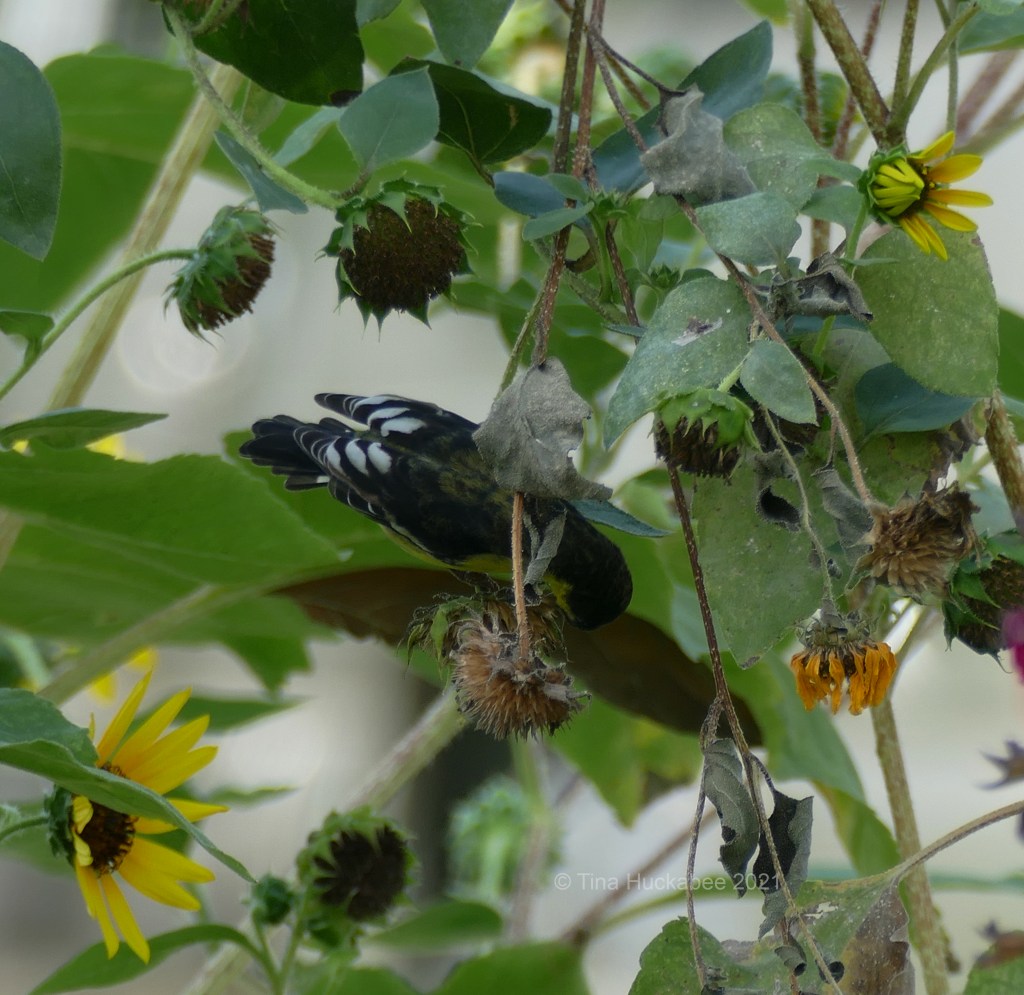
The sunflowers are definitely the stars of the garden show, but it hasn’t been all sunshine with the sunflowers. For about 18 months, I’ve experienced random outbreaks of itchy, angry red rashes, typically on my legs and arms. I couldn’t figure out what was triggering the annoying and very uncomfortable rashes–until this summer. In conversations with my SIL and other sunflower-growing neighbors, I learned that they were experiencing reactions to the sunflowers, resulting in itchy rashes. I realized that it was the sunflowers that were causing my itchy-scratchies, but it couldn’t only be the sunflowers. The rashes have occurred in autumn and late summer, too, when these particular sunflowers (that come from bird feeder black-oiled sunflower seeds), are done for the year and pulled from the garden. With observation, I then recognized that the native Plateau goldeneye, Viguiera dentata that I grow and which blooms in late summer and fall, also was resulting in my rashes. Both plants are in the Aster, or Asteraceae, family of plants, and I grow quite a few other Aster plants: Purple coneflower, Zexmenia, Gregg’s mistflower, Blue mistflower to name a few. So far, I think I’m safe with most of the Aster family plants, as long as my contact is limited; just brushing against most of them (not the two main culprits) doesn’t to end with me scratching for days and looking for relief. When I have experience outbreaks, I’ve taken Allegra and I have a prescription hydrocortisone cream; both are helpful. Even so, it takes a week or more for the rashes to clear up.
I’ve always been a t-shirt and shorts girl-in-the-garden, but I’m now covering up when I have work to do: long linen pants, some shirts from The Hub, and equestrian gloves which cover my arms to the elbows. And, when it’s hot and sunny, a hat. In the new gardening get-up I’m avoiding new rash outbreaks and it’s good to know that I can still garden, even if I look ridiculous.
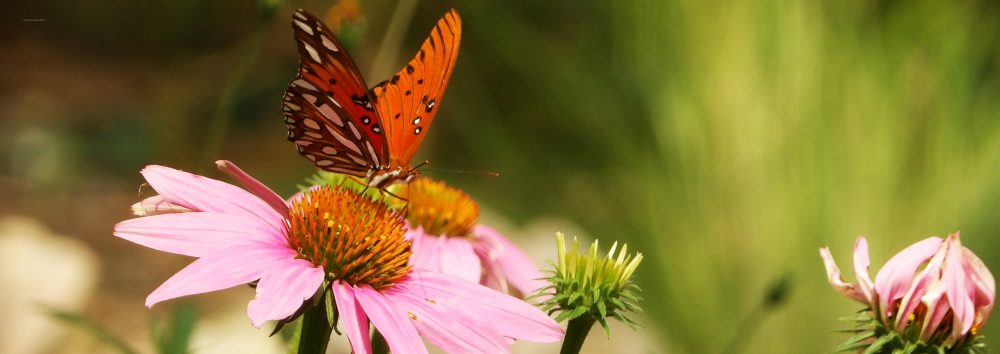
That is a lot of sunflowers. I think germination rate was higher this year after the freeze. I did not know they could give you rashes…yuck. I only have Swamp Sunflowers, which I regret planting.
LikeLike
It’s a lot of sunflowers. Next spring, I’ll be more vigilant in removing them though I’ll always want some in the garden, they’re just too summery. I was surprised about the contact dermatitis, but I guess allergies can develop where they weren’t before. Darn it!
LikeLiked by 1 person
I remove all the seeds from the Swamp Sunflowers to keep them under control. I always miss some seeds and the plants will come back from the roots. I find that ant bites bother me more. I guess things change.
LikeLike
Oh my word, what a brilliant consequence of feeding the birds! Sorry to hear that they are causing you skin problems though. It’s tragic to see those trees in such a sorry state. Will you replace them with other trees to recreate the shade eventually?
LikeLike
It’s been a huge year for sunflowers; they’re everywhere, not just in my area. I suspect that deep freeze we experienced was somehow good for the overwintering seeds. As to the tree, yes there’s already a replacement. At the far left of the photo that shows both our front gardens and behind that group of sunflowers (of course…) there’s an almost 6 foot lovely Red oak tree, gifted by a squirrel or bird. https://www.wildflower.org/plants/result.php?id_plant=qubu2 I have Red oaks in my back garden and there are many in this area, so this one is probably a natural hybrid. I first saw the gorgeous red foliage 3 or 4 years ago underneath the perennials which grow around it. It’s grown quickly, though I won’t see it in its full height. Still, it’ll be producing some shade in just a few years. My SIL is going to plant a different kind of oak, a Monterrey oak: https://www.wildflower.org/plants/result.php?id_plant=qupo2.
LikeLiked by 1 person
Wow, a hedge of sunflowers! They are huge. It is heartening to see the birds using them.
Sad about your trees. Losing a mature tree that provided welcome shade is a blow. Any tree you plant now won’t replace them, but will be enjoyed by the next generation, I suppose. As the saying goes, “The best time to plant a tree is 30 years ago. The second best is today.”
LikeLike
Yes! Huge! And most importantly, the sunflowers have been great for wildlife. Those poor trees; I’m going to miss both of them, but must look forward to new plants and the growth of the oak that some critter left. You’re right that the tree is for the next generation, but I’m glad it’s there for…whomever.
LikeLiked by 1 person
That is very unfortunate about the ash trees. They are related to the Modesto ash, which is a cultivar of Arizona ash, and used to be a common street tree here. Except for the anthranose, they are very resilient here, but there is no severe weather.
LikeLike
It really is, Tony. My ash tree also suffered anthracnose from time-to-time, but it didn’t set it back much, it would just grow more leaves. I didn’t know the Arizona ash was related to the Modesto ash, thanks for that information.
LikeLiked by 1 person
Modesto ash was the only Arizona ash that was popular here, but has not very unpopular for decades, because of its susceptibility to anthracnose, and its innate structural deficiency.
LikeLike
How devastating about your poor trees… I’m so very sorry to hear about that. If I had an entirely sunny yard, I don’t believe I would ever go outside, except after dark. I feel for you…
Also sad to hear about your rashes. I imagine it’s good to know what causes them but damn… Would me so much easier to accept if it wasn’t caused by something otherwise so beautiful and beneficial. Sigh…
LikeLike
Yeah, it’s a bummer, to be sure. I’m so gonna miss the life they give. Where are my birds going to go when they’re in the garden and something startles them? Sigh.
As for the sunflowers, they’re still lovely (well, less so, as they’re going to seed), I just have to dress appropriately to be around them. We have so many this year and they seed out like crazy, I’ll have to cull masses of them next year.
I still read you every week, but can’t post. 😦 Loved the photo this week!
LikeLiked by 1 person
I think you’ll have to plant another tree. Preferably one that grows fast and is heat-, drought-, and cold-tolerant.
Thanks for staying with it. I don’t know why readers can no longer comment. Mind you, I haven’t written much of significance lately anyway. But I do appreciate you putting up with the randomness of my brain. xoxo
LikeLike
I’ve noticed huge stands of sunflowers here, too. I do believe that the freeze encouraged growth in a lot of species. Our Crape Myrtles are nearly unbelievable this year. They bloomed late, but I’ve never, ever seen so many flowers on the trees, and they’re lasting for weeks longer than usual. I suppose our consistent rains have helped.
I’ve never heard of sunflowers causing a contact dermatitis, but at least you can keep it under control. On the other hand, having to don so much protective gear in this heat can’t be fun! They are beautiful, and obviously please the birds. It’s a shame about your trees. I don’t know a thing about Arizona Ash, and it might not be the kind of tree that would be suitable for such purposes, but I’ve seen a couple of dead trees in yards here that were partially cut but left in place for roosting and nesting. Of course, that might not please an HOA, or aesthetically-inclined neighbors!
LikeLiked by 1 person
I meant to leave a link to this little tidbit, since it’s both sunflower related and funny.
LikeLiked by 1 person
I thought about keeping the tree as a large shrub, but would have to completely revamp the garden–and I mean completely. I will have enough to do in the next year or so in replacing some of the more shade loving plants with sun lovers. I decided the best thing is to take it down, but it wasn’t a happy decision. My SIL’s tree is huge and will require a permit to remove. She’s going to have the crew create some levels in the trunk for some container plants; that should be nice, I think. She actually put out a call for a chainsaw artist to maybe create a Maneki-neko cat: https://en.wikipedia.org/wiki/Maneki-neko Unfortunately, there were no takers. Our neighborhood is just quirky enough that she probably wouldn’t have had any complaints about that. 🙂
LikeLiked by 1 person
I might have just the artist for your sister. His name is Earl Jones, and he’s from Galveston. He not only did many of the trees in Galveston after Ike, he created a marvelous angel that I’ve written about. I’ll leave that link below so this doesn’t get thrown into spam or moderation. Your sister might not be interested any longer, but Earl would do a wonderful job.
LikeLike
Here’s the link to the angel story and more about Earl.
LikeLike
Thanks for that, Linda. I remember that blog post and when I scrolled through it just now, remembered the angel–stunning. I passed this information on to Sharon. It’s pretty expensive to have these trees removed and that Mr. Jones lives in Galveston, would add to the cost, but she might be interested. Thanks so much for that. I love his work!
LikeLike
Oh dear, sorry about the rashes. I’ve been surprised to see some goldenrods starting to bloom–that seems early for us, but we did have a hot spring and a hot start to summer. The sunflowers are just starting (yay!). No asters blooming yet, though. This part of summer is so beautiful in the prairies. Sorry about the trees. 😦
LikeLike
Our goldenrods don’t bloom until September/October and they’re so pretty. I’ll bet this time of year is gorgeous in Wisconsin!
Thanks for your condolences on the trees. I’m sorry too, but will be able to plants some thing that I’ve never been able to grow in shade, so that’s a bit of a consolation.
LikeLike
Your garden accords with what I’ve been seeing as I drive around town: colonies of “common” sunflowers seemingly everywhere. I don’t remember ever seeing so many this late into the summer. I’ve wondered if the February freeze retarded their normal cycle. In the opposite temporal direction, I saw a few tall Maximilian sunflower plants already flowering two days ago. The death of your two Arizona ash trees reminds me that I still haven’t seen a single huisache that survived.
Because my skin is sensitive to many things, I always wear full-length jeans and a long-sleeve shirt when I go out into nature, even in the peak heat of August. My clothing gets soaked through with sweat but I find that preferable to itchy rashes.
LikeLike
The sunflowers have been numerous and massive this year. Along with other annuals and some perennials, they seem to have liked that cold, cold week.
I’m more careful now when I’m in the garden and on walks/hikes; long pants and covered arms for me!
LikeLike
How can anyone not love sunflowers? Sorry to hear about your trees, though.
LikeLike
Sunflowers are pretty lovable, I agree!
LikeLike
I’m so sorry for the rashes you have. You are very good at wearing long pants, long-sleeved shirts and gloves: I always use them too because my skin is very delicate and I get rashes right away. It’s a great shame that your Arizona ash trees died from the extreme cold winter storm. You will miss them a lot. Sunflowers are divine and joyful. For pollinators they are a great source of food, as for birds sunflowers that have already created pipes. I’m really sorry you get an allergy, but they are beautiful. Hope your back is improving. Tina I have not written in your blogs because I have had an attack in my lower back and my herniated discs for more than a week, caused by taking 50 l bags of soil while cleaning the terrace of soot. She hit me so hard that I had to lie in bed with pain in my legs, groin, lower back, waist, back, neck and unable to sit up. Now I’m a little better and I can sit on the sofa for a few hours and yesterday and today I picked up the computer a little bit, but my back hurts a lot when I write. I hope you and Bee Daddy are in good health. Take good care of both of you. Loving hugs. Have a great week. Very affectionate greetings from Margarita.
LikeLike
I hope you rest your back in the coming days and weeks, Margarita, so that you can recover more quickly. Take good care of yourself and your mother and don’t work too hard–the work will get done soon enough.
LikeLiked by 1 person
Tina thank you very much for your kind words. I will listen to you and rest. What happened to me is my fault: I can’t lift weights but I do it and then I pay for it. But I am like this!! Don’t worry, I will take good care of my Mother: the two of us are a good team. We are in no rush to finish cleaning. We won’t paint until September, so it will be less hot. Tina thank you again for your concern for my Mother and for me. Take care. Sweet hugs. Very affectionate greetings from Margarita 😘😀
LikeLike
You’ve had a run of bad luck recently, but I hope things will improve for you very soon. It’s wise to wait until September to paint, so it won’t be so hot. Good luck with everything, Margarita.
LikeLike